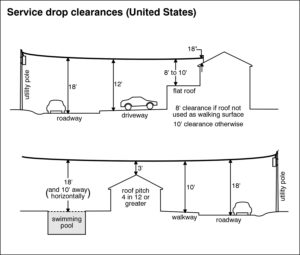Electric Safety
Some might think walk in or accessing a roof is the least safe element of a commercial property inspection. While the roof can be dangerous the single most unsafe element of a commercial building inspection is the electric.
If you are a “residential inspector” you are used to having services of 60 to 200 amps. A commercial property might have a service of 1000, 2000 maybe even 6000 amps. This size can be very hair raising and extremely dangerous. This is why you have to pay attention to the details and stay safe. This safety also goes beyond the inspector to the client as well anyone else that will ever come into contact with the electric service ever again.
The nice thing about inspecting the electric service and system is that there is a great deal of transfer between the residential and commercial inspection. For example: the overhead service has to be at least 10 feet off the ground or 12 feet above a drive or 18 feet above a road or alley. The overhead service also has to have a driven rod ground.

Another and very important similarity is the dedicated space or panel clearance rule. All electric devices require a minimum of 30 inches of side to side clearance and 36 inches of front clearance. There must also be at minimum off 6 feet 6 inches of height around the electric. This is called the work zone. No other systems or devices other than electric can be located in that zone. One of the most common issues found during a commercial inspection is the encroachment into the dedicated space by other devices or stored items in front of electrical equipment or gear.

The inspector will open every dead front cover and look for visual clues that there are issues present. These could be open knockouts, where electric connections might have been removed, or missing breakers where a finger can come into direct contact with the interior of the panel or a lack of labeling. Panels larger than 200 amp will typically not be removed and panels that require specific access or high voltage service will not. In many cases the electric distribution will change when a building is being repurposed to a new buyer so the inventory is very important but the exact distribution is not as important.
Beyond the sheer size of the electric system and service there are also the increased number of panels located in a building. A home might have one or two panels but it is not uncommon to see as many as twenty or thirty in a commercial building. This increase in number only multiplies the inspector’s exposure to danger.
A good inspector keeps their eye out for all the various dangers in a building, especially electric. Noting the open junction boxes, loose distribution cables or conduit or just broken devices are all part of what is lurking in front of the inspector at any given moment of time.